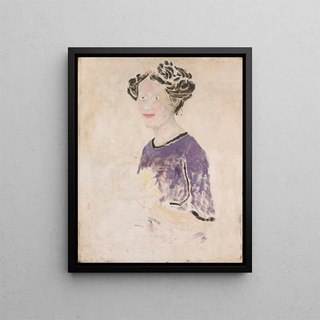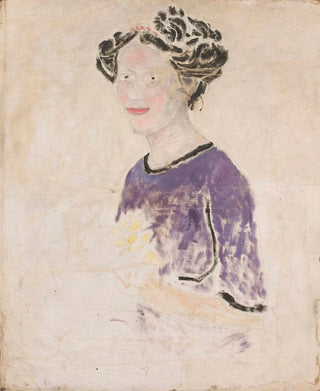Art print | Woman in Lilac Dress - Tadeusz Makowski


View from behind

Frame (optional)
Femme in lilac dress - Tadeusz Makowski – Captivating introduction
In the vibrant universe of art, some works manage to capture the very essence of human emotion. "Femme in lilac dress - Tadeusz Makowski" falls into this category, evoking a palpable curiosity in the viewer. This piece, both delicate and vibrant, invites deep contemplation. It evokes an atmosphere of softness and mystery, where the depicted woman seems to be both a muse and an enigma. The artist, through his chromatic choices and composition, immerses us in a world where beauty and melancholy coexist, encouraging us to explore the subtleties of the feminine soul.
Style and uniqueness of the work
Tadeusz Makowski's style is distinguished by his unique approach to color and form. In "Femme in lilac dress," the chosen color palette is both soothing and enchanting. Lilac, a symbol of delicacy, is enhanced by touches of complementary shades that create a captivating visual harmony. The composition, meanwhile, plays with flowing lines and gentle contours, giving the female figure timeless grace. The artist manages to convey an impression of lightness, as if the woman is floating in a dreamlike space. This artwork is also characterized by a slightly stylized realism, where the woman's features are both recognizable and idealized, offering a poetic vision of femininity.
The artist and his influence
Tadeusz Makowski, Polish painter of the early 20th century, made his mark with an innovative approach to painting. Influenced by the Symbolist movement and Impressionist currents, he developed a personal style that blends tradition and modernity. His work, although rooted in a specific historical context, transcends temporal and geographical boundaries. Makowski was interested in representing women not only as an aesthetic subject but also as a symbol of the complexity of human emotions. Through his creations, he manages to establish a dialogue between the viewer and the work, inviting each to introspect on beauty and fragility.

Matte finish

View from behind

Frame (optional)
Femme in lilac dress - Tadeusz Makowski – Captivating introduction
In the vibrant universe of art, some works manage to capture the very essence of human emotion. "Femme in lilac dress - Tadeusz Makowski" falls into this category, evoking a palpable curiosity in the viewer. This piece, both delicate and vibrant, invites deep contemplation. It evokes an atmosphere of softness and mystery, where the depicted woman seems to be both a muse and an enigma. The artist, through his chromatic choices and composition, immerses us in a world where beauty and melancholy coexist, encouraging us to explore the subtleties of the feminine soul.
Style and uniqueness of the work
Tadeusz Makowski's style is distinguished by his unique approach to color and form. In "Femme in lilac dress," the chosen color palette is both soothing and enchanting. Lilac, a symbol of delicacy, is enhanced by touches of complementary shades that create a captivating visual harmony. The composition, meanwhile, plays with flowing lines and gentle contours, giving the female figure timeless grace. The artist manages to convey an impression of lightness, as if the woman is floating in a dreamlike space. This artwork is also characterized by a slightly stylized realism, where the woman's features are both recognizable and idealized, offering a poetic vision of femininity.
The artist and his influence
Tadeusz Makowski, Polish painter of the early 20th century, made his mark with an innovative approach to painting. Influenced by the Symbolist movement and Impressionist currents, he developed a personal style that blends tradition and modernity. His work, although rooted in a specific historical context, transcends temporal and geographical boundaries. Makowski was interested in representing women not only as an aesthetic subject but also as a symbol of the complexity of human emotions. Through his creations, he manages to establish a dialogue between the viewer and the work, inviting each to introspect on beauty and fragility.






